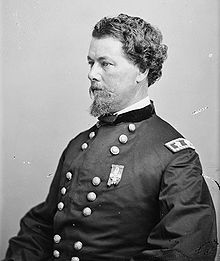Horatio G. Wright
| Horatio Gouverneur Wright | |
|---|---|

Horatio G. Wright
|
|
| Born |
March 6, 1820 Clinton, Connecticut |
| Died | July 2, 1899 (aged 79) Washington, D.C. |
| Place of burial | Arlington National Cemetery |
| Allegiance | |
| Service/branch | |
| Years of service | 1841–1884 |
| Rank |
|
| Commands held |
Department of the Ohio Army of the Ohio VI Corps U.S. Army Corps of Engineers |
| Battles/wars | |
Horatio Gouverneur Wright (March 6, 1820 – July 2, 1899) was an engineer and general in the Union Army during the American Civil War. He took command of the VI Corps in May 1864 following the death of General John Sedgwick. In this capacity, he was responsible for building the fortifications around Washington DC, and in the Overland Campaign he commanded the first troops to break through the Confederate defenses at Petersburg. After the war, he was involved in a number of engineering projects, including the Brooklyn Bridge and the completion of the Washington Monument, and served as Chief of Engineers for the U.S. Army Corps of Engineers.
Wright was born in Clinton, Connecticut, son of Edward and Nancy Wright. When he was 14 he entered Alden Partridge's military academy in Vermont (now Norwich University). In 1837 he entered West Point and graduated second in his class of 52 from the United States Military Academy in 1841 with a commission in the engineers. He taught engineering and French at West Point over the next several years. He was sent to Florida in 1846, where he spent ten years working on the harbor of St. Augustine and the defenses of Key West, including Fort Jefferson. In 1855, he was promoted to the rank of captain and served as assistant to Chief of Engineers Colonel Joseph G. Totten the following year. During this time, he was appointed as a member of a military committee to study iron carriages for the construction of naval guns and ordnance specifications of the 15-inch gun. He later co-wrote Report on Fabrication of Iron for Defenses (published in 1871–72) based on his time on the board.
...
Wikipedia
